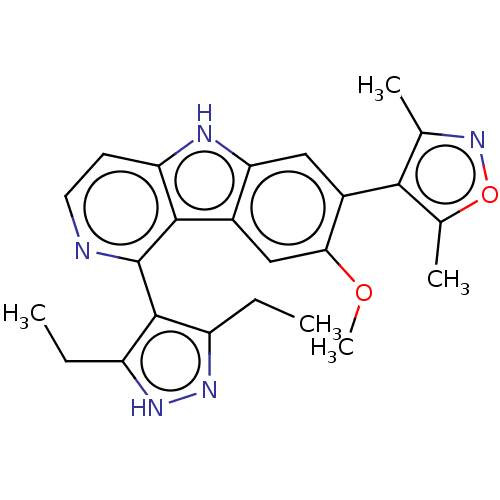TargetBromodomain-containing protein 3 [51-123](Homo sapiens (Human))
THE REGENTS OF THE UNIVERSITY OF MICHIGAN
US Patent
THE REGENTS OF THE UNIVERSITY OF MICHIGAN
US Patent
Affinity DataKd: 17nMpH: 7.4Assay Description:Biotin labeled BRD proteins (10 μg/ml) in kinetic assay buffer (PBS, pH 7.4, 0.1% BSA and 0.01% Tween-20) were immobilized on Super Streptavidin...More data for this Ligand-Target Pair
TargetBromodomain-containing protein 3 [51-123](Homo sapiens (Human))
THE REGENTS OF THE UNIVERSITY OF MICHIGAN
US Patent
THE REGENTS OF THE UNIVERSITY OF MICHIGAN
US Patent
Affinity DataKd: 18nMpH: 7.4Assay Description:Biotin labeled BRD proteins (10 μg/ml) in kinetic assay buffer (PBS, pH 7.4, 0.1% BSA and 0.01% Tween-20) were immobilized on Super Streptavidin...More data for this Ligand-Target Pair
TargetBromodomain-containing protein 3 [51-123](Homo sapiens (Human))
THE REGENTS OF THE UNIVERSITY OF MICHIGAN
US Patent
THE REGENTS OF THE UNIVERSITY OF MICHIGAN
US Patent
Affinity DataKd: 18nMpH: 7.4Assay Description:Biotin labeled BRD proteins (10 μg/ml) in kinetic assay buffer (PBS, pH 7.4, 0.1% BSA and 0.01% Tween-20) were immobilized on Super Streptavidin...More data for this Ligand-Target Pair
TargetBromodomain-containing protein 3 [51-123](Homo sapiens (Human))
THE REGENTS OF THE UNIVERSITY OF MICHIGAN
US Patent
THE REGENTS OF THE UNIVERSITY OF MICHIGAN
US Patent
Affinity DataKd: 21nMpH: 7.4Assay Description:Biotin labeled BRD proteins (10 μg/ml) in kinetic assay buffer (PBS, pH 7.4, 0.1% BSA and 0.01% Tween-20) were immobilized on Super Streptavidin...More data for this Ligand-Target Pair




